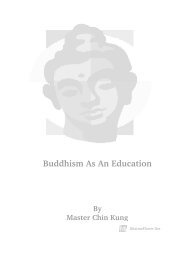Vipassana Meditation : Lectures On Insight Meditation by Venerable
Vipassana Meditation : Lectures On Insight Meditation by Venerable
Vipassana Meditation : Lectures On Insight Meditation by Venerable
You also want an ePaper? Increase the reach of your titles
YUMPU automatically turns print PDFs into web optimized ePapers that Google loves.
can observe the five precepts perfectly, our morality is purified. When moralconduct is purified, a meditator can easily practice meditation, either Samathaor <strong>Vipassana</strong> meditation. Based on purification of moral conduct, a meditatorcan easily concentrate on the object of meditation and gain deepconcentration, where<strong>by</strong> the mind is clear, serene and happy.Practical AspectNext, we have the fourth aspect, i.e. the practical aspect of Buddhism. Wemust practice meditation so that we can deliver ourselves from defilementsand, as a result, attain the cessation of all kinds of suffering. Here, we practicetwo kinds of meditation which make up the practical aspect of Buddhism - oneto enable us to attain deep concentration, and the other to enable us to attainthe cessation of suffering through the realization of mentality and physicalityin their true nature. The Buddha stressed the second type of meditation -<strong>Vipassana</strong>-meditation. When we practice <strong>Vipassana</strong> meditation, we have tofollow the Maha Satipatthána Sutta, the discourse on the Four Foundations ofMindfulness. If we apply mindfulness to all our mind-body processes,we are sure to attain the cessation of suffering. The Buddha described thefour Foundations of Mindfulness when he gave the discourse on MahaSatipatthána Sutta in Kuru province.Seven Benefits of <strong>Meditation</strong>In the introductory passage of that Sutta, the Buddha explained the sevenbenefits, which a meditator can gain through his own experience of Dhamma.The First Benefits purification. When a person practices mindfulness, hecan purify his being from all defilements. The Pali word 'kilesa' may be familiarto you. The word 'kilesa' is translated as defilements <strong>by</strong> Buddhist scholars. Thekilesa are of ten main kinds:1. Lobha2. Dosa3. Moha4. Ditthi5. Mana6. Vicikiccha7. Thina-middha20









